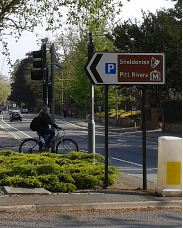Oxford is a city that is full of tourists, and in the UK where there are tourists, there are brown signs to direct them to the attractions. As well as the name of the attraction, a sign often also has what might best be called (by analogy with IT) an icon. The sign in the picture shows the word ‘Sheldonian’ and a mask – the icon for a theatre. As you might guess, it directs you to the Sheldonian Theatre. So far so good.
There is just one problem. The theatre in question is not a place where you go to see plays. It is in fact the main ceremonial building of the university, where amongst other things, students are admitted, and all being well, later receive their degrees. I don’t suppose it confuses proud parents attending the ceremony, but I wonder what less well-informed tourists make of it?
Poor branding
I won’t speculate on whether the person who designed the sign realised what they were doing, but it reminded me of an important business truth. Broadly interpreted, what happened here was poor branding – the icon was inconsistent with the meaning, potentially leading to confusion and frustration. The importance of consistency and integrity of messages is universal, whether or not the messages we are giving would conventionally be thought of as branding. When everything we see and hear is consistent, we believe in the authenticity of the message, and that builds trust, be it in a product, an organisation, a person, or a set of signs. When we realise that that consistency is lacking, trust is lost – even if only in the brown signs.
Any time you want to build trust, think of yourself as managing your own brand. As change managers, the ability to build trust is one of our most important skills – so we can’t afford poor branding. Whatever and however you are communicating (particularly when you are not deliberately communicating at all!), be authentic – then you will also have that essential consistency.
Perhaps it does not matter if one set of signs has an odd choice of image, or just how much the signs are trusted. But how many times have you made similar mistakes, which may have had worse consequences?


